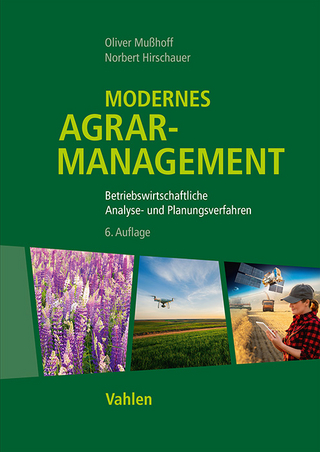
Current Challenges for the Aquatic Products Processing Industry
Iste Ltd (Verlag)
978-1-78945-149-8 (ISBN)
This book should be helpful for processors, fish traders, consumers, scientists and students. The first chapter is dedicated to the sociological definition of "fish" and consumers’ perceptions. The following chapters deal with the notions of quality sensu lato, biological risks and their control, as well as the risks linked to the pollution of oceans and ecosystems by microplastics. Two types of processes and processed products – smoked fish and surimi products – which are of great economic importance to the European market, are also presented. The process of adding value to co-products, including the "blue biorefinery" and the innovative pH-shift technology are also covered in this book.
Véronique Verrez-Bagnis is a senior researcher in food science at Ifremer, France. She has worked on functional properties and post-mortem degradation of fish muscle proteins, fish species authentication and fish parasites. Her recent research is more focused on blue biotechnologies.
Preface xi
Véronique VERREZ-BAGNIS
Chapter 1 Consumer Perceptions of "Fish" Food 1
Gervaise DEBUCQUET
1.1 Introduction 1
1.2 Thinking about fish 2
1.2.1 Naming the unknown 2
1.2.2 The imaginary of the marine world: permanence and metamorphosis 3
1.2.3 The representations associated with marine foods: the historical legacy 4
1.3 Eating fish 5
1.3.1 Dealing with animality 5
1.3.2 Fish today, between pleasure and nutrition 6
1.4 Reconnecting with the fish animal? 8
1.4.1 A culinary exoticism: raw fish 8
1.4.2 The local distribution channels of fish 9
1.5 Conclusion 10
1.6 References 10
Chapter 2 Fish Quality and Freshness 13
Grethe HYLDIG
2.1 Introduction 13
2.2 Factors that affect the sensory quality 13
2.2.1 Genetic 14
2.2.2 Age 16
2.2.3 Time of year 16
2.2.4 Environment and aquaculture 17
2.2.5 Feed 17
2.2.6 Catch handling and slaughter 18
2.2.7 Temperature and storage 20
2.2.8 Processing and products 21
2.3 The use of sensory measurements in the quality control in the fish industry 23
2.3.1 Sensory methods used for measuring freshness and sensory quality 24
2.4 References 30
Chapter 3 Nutritional Value of Finfish 33
Irineu BATISTA and Carla PIRES
3.1 Introduction 33
3.2 Nutritional value of finfish 33
3.2.1 Proximate composition 34
3.2.2 Fatty acids 40
3.2.3 Amino acids 53
3.2.4 Vitamins 54
3.2.5 Minerals 55
3.3 Future trends 57
3.4 References 57
Chapter 4 Fish Traceability and Authenticity 63
Carmen GONZÁLEZ SOTELO, Valur GUNNLAUGSSON, Ute SCHRÖDER, Rogério MENDES, Kristina KAPPEL, Helena SILVA and Véronique VERREZ-BAGNIS
4.1 Introduction 63
4.2 Seafood traceability 65
4.2.1 Food safety and traceability legal requirements 67
4.2.2 Definitions of traceability 67
4.2.3 Traceability main features 68
4.2.4 Traceability systems 69
4.2.5 Why is full seafood chain traceability not more common? 69
4.2.6 Implementing a traceability system 71
4.2.7 Example of data gathering and information exchange in the seafood sector 72
4.2.8 The way forward 74
4.3 Analytical methods for the control of seafood traceability and authenticity 75
4.3.1 Species identification tools 75
4.3.2 Identification of geographic origin in seafood 84
4.3.3 Wild and farmed seafood discrimination 87
4.3.4 Detection of water addition, frozen–thawing and discoloration 89
4.4 Needs and developments to improved traceability and authenticity for fish industries 92
4.4.1 Standardization 92
4.4.2 Online iTool FISH-FIT 94
4.5 References 95
Chapter 5 Bacterial Risks and Biopreservation of Seafood Products 113
Sabrina MACÉ, Delphine PASSERINI and Françoise LEROI
5.1 Introduction 113
5.2 Microbiota, microbial risk and product quality 114
5.2.1 Methods for studying the microbiota of seafood 114
5.2.2 Pathogenic bacteria and microbiological risks 117
5.2.3 Seafood spoilage bacteria 121
5.3 Biopreservation of seafood products 123
5.3.1 Bacterial interactions 124
5.3.2 Selection of bioprotective microorganisms 126
5.3.3 Examples of the application of protective cultures in seafood 131
5.3.4 Regulatory aspects 135
5.4 Conclusion 136
5.5 References 137
Chapter 6 Fish Parasites and Associated Risks 147
Mélanie GAY and Véronique VERREZ-BAGNIS
6.1 Introduction 147
6.2 Prevalence and significance of parasitosis for the sector 148
6.2.1 Protists 148
6.2.2 Microsporidia and mesomycetozoea 149
6.2.3 Stramenopiles 150
6.2.4 Metazoans 151
6.3 Emerging parasitosis 162
6.4 The special case of aquaculture species 164
6.5 Allergies related to the presence of parasites 165
6.6 The legislative framework for consumer protection or regulatory requirements for parasites in aquatic products 167
6.7 Methods for the detection of parasites and mainly nematode larvae 168
6.8 Identification of parasites 170
6.8.1 Identification of nematode larvae 170
6.8.2 Identification of other parasite species 170
6.9 Prevention and control of parasite risk 171
6.10 Future perspectives and approaches 173
6.11 References 175
Chapter 7 Microplastics 187
Alexandre DEHAUT and Guillaume DUFLOS
7.1 What are microplastics? 187
7.1.1 Different chemical compositions 188
7.1.2 Importance of the notion of size 189
7.1.3 A diversity of forms within microplastics 190
7.1.4 Carrying of chemical and biological contaminants by microplastics 191
7.2 Analysis of microplastics in seafood 192
7.2.1 Isolation of microplastics 192
7.2.2 Identification of the polymeric nature 192
7.2.3 Contamination management 193
7.2.4 A problem that is beginning to emerge 193
7.3 Contamination status in consumed marine species 193
7.3.1 Shellfish 194
7.3.2 Crustaceans 194
7.3.3 Fish 195
7.3.4 Cephalopods 197
7.3.5 Other species consumed 197
7.4 Contamination status in processed products containing fish 198
7.5 Importance of risk assessment in the context of microplastic contamination 201
7.5.1 Human exposure 201
7.5.2 Toxicological impact 202
7.6 Concluding remarks 202
7.7 Acknowledgements 203
7.8 Appendix: List of consumed species for which microplastic contamination has been documented 203
7.9 References 211
Chapter 8 Smoking: A Flavoring and Preservation Technique 229
Régis BARON
8.1 Introduction 229
8.2 Role of the main manufacturing steps 231
8.3 Factors influencing conservation 232
8.3.1 Factors influencing alteration 233
8.3.2 Factors influencing sanitary quality 235
8.3.3 Other manufacturing steps that may affect preservation 238
8.4 The different technologies of salting – drying – smoking 241
8.4.1 Salting 241
8.4.2 Drying 243
8.4.3 Smoking 244
8.5 Conclusion 249
8.6 Acknowledgements 249
8.7 References 250
Chapter 9 Surimi and Derived Products 253
María Pilar MONTERO GARCÍA and Antonio Javier BORDERÍAS
9.1 Introduction 253
9.2 Surimi sources 253
9.2.1 Alaska pollock 254
9.2.2 Pacific whiting 255
9.2.3 Southern blue whiting and hoki 255
9.2.4 Northern blue whiting 256
9.2.5 Tropical fish 256
9.3 Manufacture of surimi 257
9.3.1 Stages of surimi manufacture from lean species 258
9.3.2 Stages of surimi manufacture from fatty species 259
9.3.3 Surimi stabilization, use of additives for preservation 260
9.4 pH shift process 262
9.4.1 pH shift process in fish 262
9.4.2 pH shift process in cephalopods 264
9.5 Mechanism of gel formation 265
9.5.1 Heating methods for gel formation 267
9.5.2 Gelation of fish protein isolate with pH shift processing 269
9.6 Waste management, food-grade coproducts and other materials 269
9.6.1 Main types of by-products generated in surimi manufacture 270
9.7 Surimi seafood products 272
9.7.1 Types of products 272
9.7.2 Ingredients for surimi products 275
9.8 References 279
Chapter 10 Little or Underutilized Marine Resources 287
Charles DELANNOY
10.1 What resources are not or hardly used in the fishing industry? 287
10.1.1 What are marine co-products? 288
10.1.2 What are the volumes of co-products? 289
10.2 The opportunities 290
10.3 Products and processes 291
10.3.1 Production of fishmeal and fish oil 291
10.3.2 Production of hydrolysates 294
10.3.3 Fish pulp 298
10.3.4 Ingredients for nutraceuticals and health nutrition 300
10.4 Synthesis of extracted products from marine co-products 305
10.5 Conclusion 307
10.6 References 307
Chapter 11 Biorefinery of Underutilized Marine Resources Using the pH-Shift Technology 309
Mehdi ABDOLLAHI
11.1 Introduction 309
11.2 Multiple-product blue biorefinery 310
11.3 pH-shift technology and its fractionation principles as a biorefinery tool 311
11.4 Isolation of functional proteins using the pH-shift technology 314
11.5 Cold extraction of fish oil parallel with gel-forming proteins 317
11.6 Collagen extraction using the pH-shift technology 320
11.7 Conclusions and future prospects 322
11.8 References 322
List of Authors 327
Index 329
| Erscheinungsdatum | 16.01.2024 |
|---|---|
| Verlagsort | London |
| Sprache | englisch |
| Gewicht | 762 g |
| Themenwelt | Wirtschaft ► Betriebswirtschaft / Management |
| ISBN-10 | 1-78945-149-3 / 1789451493 |
| ISBN-13 | 978-1-78945-149-8 / 9781789451498 |
| Zustand | Neuware |
| Informationen gemäß Produktsicherheitsverordnung (GPSR) | |
| Haben Sie eine Frage zum Produkt? |
aus dem Bereich


